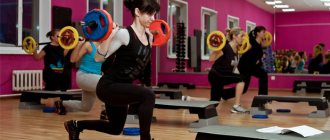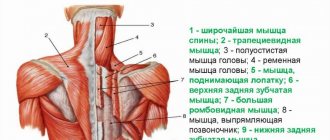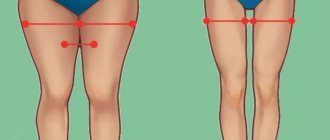Shoulder exercises help create a beautiful relief, neat contour and volume. But in this matter, the following are important: systematicity, a well-planned training program, and planned loads. You should choose the type of exercise that will allow you to work out the locally necessary muscle groups. But in order to know exactly what to focus on, you need to at least understand the anatomical structure of human shoulders.
What muscles are included in the anatomy of the shoulders?
The shoulder girdle connects the arms to the body. And the shoulder starts from the upper joint and ends in the elbow area. And these two concepts should be distinguished, because many are accustomed to perceive them as one whole.
Therefore, let's first look at which muscles are located where, so that later, when performing exercises, we can distribute the load to those muscle groups that especially need it.
Upper limb belt includes:
- deltoid muscle (forms a pronounced bulge, helps strengthen the shoulder joint);
- supraspinatus and infraspinatus muscles;
- teres minor and teres major muscles.
The shoulder consists of the following types of muscles:
- coracobrachial;
- brachial;
- two-headed;
- triceps;
- ulnar.
We won’t talk in detail about the anatomical features of all groups and types; let’s go straight to the main thing - we’ll figure out how to pump up the shoulders, taking into account the location of each type of muscle on the human body.
How to pump up your middle deltoids
Goal: building up the middle deltoid muscles To make your shoulders wider, you need to develop the middle deltoid muscles. This will also allow the waist to appear narrower and give rise to a wider shoulder girdle. The emphasis in this program, naturally, is on exercises for the middle deltas.
You will perform them at the beginning of the workout, when energy is at its highest level. You can alternate this program with a more balanced delt workout (like mass) during your weekly split.
A set of exercises for the middle deltoids
- Seated overhead press - 4 sets of 8 reps (2 minutes rest)
- Barbell Chin Row - 3 sets of 8-10 reps (60-90 seconds rest)
- One-arm dumbbell lateral raises - 3 sets of 10 reps (60-90 seconds rest)
- Standing dumbbell lateral raises - 3 sets of 10-12 reps (60-90 seconds rest)
Effective exercises for training
There are various training sets, including both basic and local (isolated) sets of exercises. But let's sort it out in order.
Lifting the weight up (base)
These classes are especially effective and efficient for those who want to increase delt mass. The main load is taken by the anterior and lateral zones of the deltoid muscles. The execution technique includes five main sequential actions:
- sit down on a bench and then put the apparatus on your shoulders (someone should help you with this);
- bring your shoulder blades together and push your chest forward;
- grab the bar wider than your shoulders;
- lift the barbell above your head until your arms are fully extended. Make sure your head is slightly tilted forward. Remember about breathing - you cannot hold it, exhale is always done while straightening your arms;
- the last stage is the slow return of the bar to its original position. Repeat the shoulder exercise for a few more sets.
To reduce pressure on the spine, you should choose a bench with a backrest.
Overhead chest press
It should be done by analogy with the previous option. Please note:
- the bar is placed not behind the head, but on the chest;
- when lowering the sports equipment, it is necessary to move your elbows slightly forward;
- When pressing the barbell up, do not change your body position (do not lean back or bulge forward). Try to keep your body as straight as possible and your arms in the same plane as your body. Remember to breathe correctly - straighten your arms, exhale, and then inhale smoothly. Don't hold your breath.
This type of training shifts the main load to the anterior deltoid muscles.
Chin pull
This basic shoulder exercise is recommended to be performed with dumbbells or a curved EZ bar. This will take the stress off your wrists. Thanks to this, they will take the most natural position.
Technique:
- take a barbell or dumbbells so that the girth is slightly narrower than shoulder width;
- your arms must be slightly bent at the elbows;
- using the shoulder muscles, pull the projectile up almost to the chin (but do not touch it), reducing the tension in the triceps and biceps as much as possible;
- try to ensure that your shoulders are always lower than your forearms. Lower the dumbbells. This must be done a little slower than when lifting. This way you can distribute the load evenly. You should also remember about breathing - at the highest point, exhale, when lowering the projectiles, inhale slowly.
Hands to the side
Above we looked at the base. These workouts should be done with special equipment in the gym. Let's move on to local exercises that can be performed without problems at home with minimal sports equipment.
The first option is to raise your arms to the sides. To perform this, you will need dumbbells of optimal weight.
In this case, we pump the shoulders in the area of the middle delta beams. The technique consists of five main actions:
- stand straight, bend your elbows slightly;
- begin to slowly lift the dumbbells to the sides. Do this until your arms are parallel to the floor;
- fix the position of your hands for a few seconds;
- begin to slowly return the dumbbells to their original position, lowering them.
Important! The arms should be slightly bent at the elbow. The main goal of this exercise is not to raise them as high as possible, but to ensure that the shoulders are perfectly parallel to the floor.
Watch your momentum, do not swing your body, lean back or lean forward.
"Arnold Press"
This is the best shoulder exercise that allows you to fully work out the front deltoids. To do this you will also need a pair of dumbbells of suitable weight. It consists of the following actions:
- take dumbbells, turn your palms towards you;
- now you need to bend your arms at the elbows and, without spreading your palms, press your shoulders to your body;
- after that, start pressing the dumbbells up. Moreover, it is important not to “throw” them out with jerks, but to smoothly lift them, rotating your wrists at a time when the elbow area rises to the level of the chin;
- When you return your hands to their original position, turn your wrists in the opposite direction.
To get started, just do as many repetitions as you have the strength to do. After some time, you can add 3-5 approaches.
Dumbbell Raise
This is an effective way to pump up the front deltoids. Sports equipment is raised in front of you. To do this you need:
- take the starting position standing. In this case, hands with dumbbells are located in front of the thighs;
- make a grip with your palms facing you;
- bend your elbows slightly;
- raise the dumbbells in front of you.
Important! The goal of this exercise is to ensure that the highest point of lifting the dumbbells is reached at the moment when the shoulders are parallel to the floor. You cannot raise your arms suddenly or jerkily. It is forbidden to help with the body - it must be “fixed”.
Seated press
If you do shoulder exercises at the gym, it's a good idea to try the following technique:
- sit on a bench;
- place your hands with dumbbells on your shoulders;
- push your chest forward slightly and bring your shoulder blades together;
- start squeezing the shells with slow movements, lifting them above your head and straightening your arms at the elbows;
- slowly return to the starting position.
Best Shoulder Exercises for the Back of the Deltoids
Most often, athletes neglect training these particular parts of the deltoids, because of this, looking at the athlete from the side, you can notice the lack of roundness of the rear beam. This both visually and physiologically makes the athlete stooped if the disproportion in volume is significant.
Incline dumbbell row
The row focuses the load on the back of the deltoids. Performed while resting on a bench at an angle of 30-40 degrees.
- With your chest resting on your back, your arms fall freely down.
- The weight rises upward as you exhale by bending your arms at the elbow joints strictly vertically.
- At the top point of the amplitude, a right angle should form at the elbows, and the forearms should be perpendicular to the shoulders.
- For maximum emphasis on the back, you should move your elbows up and turn your hands (little fingers up).
- As you inhale, the dumbbells return down, while at the lowest point the arms are fully straightened.
Read more about incline dumbbell rows →
Seated dumbbell flyes
Isolatedly develops the posterior part of the deltoid muscles.
- Having taken a sitting position on a bench, the athlete should tilt his torso towards his knees. The dumbbells are lowered down and under your feet.
- The movement with supination in the upper phase begins with raising the dumbbells to the sides and is performed while exhaling.
- At the top point of the amplitude, you need to take a short pause and then slowly return the weight to its original position while inhaling.
Read more about bent over dumbbell swings →
Thrust of the upper blocks in the crossover to the rear delta
This exercise develops the back of the deltoid muscles.
- To perform traction, you need to grab the upper blocks of the crossover without handles, only cables. Please note that you need to take the cable from the left block in your right hand, and the cable from the right block in your left hand.
- Having arched your back, bringing your shoulder blades together and slightly bending your elbows, as you exhale, move the blocks to the sides. The torso must be held so that the movement of the arms occurs in a vertical plane.
- As you inhale, the blocks are brought together above the level of the collarbones.
Features of drawing up a training program
All the exercises mentioned above allow you not only to pump up your shoulders, but also to create an ideal V-shaped figure. For better results, you need to train not chaotically, but according to a specific program. But there are certain features in this matter that you should be aware of:
- any shoulder training program should include sets of exercises for various muscle groups in this area. It is important to work on each zone. This is the only way to achieve ideal relief and a beautiful contour. If there is a need to work on individual parts (upper, side, front), then you should simply increase the number of approaches;
- We must not forget about pre-warming the muscles and joints - this minimizes the risk of damage;
- Each next lesson should be based on varying certain exercises and carefully working out muscle mass from different angles. This contributes to the proper development and formation of the silhouette you need;
- Don’t forget about rest and train every other day.
Structural features
This muscle is located at the top of the back and connects to the cervical spine. Three segments are conventionally distinguished. The upper section allows movement of the shoulders. The middle part is located between the shoulder blades and lifts them upward. The hem connects to the bottom of the shoulder blades and is responsible for lowering them. Thus, the muscle is necessary for turning the head up and down, moving the shoulders vertically and horizontally, and moving the shoulder blades up.
Comment from the clinic's nutritionist:
Maintaining body weight in tone ensures the correct strength load when performing basic exercises. At the same time, excellent posture is maintained and deformation of the cervical spine is eliminated. Systematic exercise to maintain muscle tone reduces the risk of chest and shoulder injuries in the future. However, inexperienced bodybuilders do not know how to quickly pump up the trapezius at home and make mistakes that lead to injuries. To avoid such problems, you need to not only correctly calculate the volume of loads based on the capabilities of your own body, but also take into account a number of other factors: from proper nutrition to a well-chosen training program. By contacting our clinic, you can receive individually developed recommendations for eating and exercise that will not harm your health, but, on the contrary, will help you achieve the desired result most effectively.
Our additional services: Bioimpedance | Marutaka Massage | Pressotherapy | Ion-Detox
Example program
A lot here depends on what goals you are pursuing.
If you want big shoulders, then the following training plan is suitable: Exercise Number of repetitions Seated dumbbell press from the shoulders up from 5 to 10 Lifting equipment in front of you from 5 to 10 Lifting dumbbells to the chin from 7 to 15 Raising arms with weight to the sides from 7 to 15 “Arnold press” 7-8 times
You must understand that good results can be obtained by doing exercises regularly and every other day.
To create a beautiful relief of the body as a whole and an ideal contour with a clear “drawing” of the muscles, the following training plan is suitable:
Exercise Number of repetitions Pressing up from the chest (with dumbbells or a barbell) about 7-8 times Pressing to the chin from 5 times Raising the arms to the side 10 times Raising dumbbells forward from 10 times Pressing a barbell behind your head from 5 times
The number of repetitions is indicated for the entry level. You can gradually increase the load by adding 2-4 sets. In addition, you can include other types of exercises in your shoulder training program, depending on what results you want to achieve.
Men should stick to the given schedule, but girls can halve the load.
To fully understand and understand how to perform the exercises correctly, we suggest you study several videos.
Exercise videos
How to build sculpted shoulders
Goal: definition of deltas
Here you will learn a good way to pump up deltoids by drawing individual fibers. Lifting light weights for high reps is no longer considered the best way to achieve delt definition. First and foremost, this indoor shoulder workout aims to stimulate muscle growth (moderate weights in a moderate rep range). To increase the number of calories burned during and after training (post-exercise oxygen consumption effect), high volume is used in combination with supersets. Here you will move faster and feel a real burning sensation in your muscles. Now you know how to pump up your muscles so that they are not only sculpted, but also the so-called “cut” appears.
Shoulder training for relief
- Seated military press - 4 sets of 8-12 reps (2 minutes rest)
- Standing Dumbbell Raises - Superset: 3 sets of 10-12 reps (no rest)
- Bent-over dumbbell raises - 3 sets of 10-12 reps (60-90 seconds rest)
- Raising your arm in front of you in a crossover - 3 sets of 10-12 repetitions (without rest)
- Crossover Chin Row - 3 sets of 10-12 reps (60-90 seconds rest)
- Butterfly raises - 3 sets of 10-12 repetitions (without rest)
- Raises of arms to the sides with an expander - 3 sets of 10-12 repetitions (60-90 seconds for rest)
Don't train your rear delts at the end of your shoulder workout.
Typically, on days when deltas are trained, the load occurs in the following sequence: middle-anterior-rear or anterior-middle-rear deltas. Whatever one may say, the back of the shoulder is left for last. Although the anterior deltoid is actively involved in all chest pressing exercises.
With the active growth of the anterior and middle fascicle, in the future, due to the disproportion of muscle development, problems with the rotator cuff may arise.
In addition, if you do not train the rear deltoid enough and do not pay attention to traction exercises for the back, the rear fascicle will be underdeveloped, and the anterior and middle fascicles will be overdeveloped in comparison, which can cause stooping.
Therefore, if the rear delts are lagging behind, always put it No. 2 after the presses, and leave the front delt in the last list.











